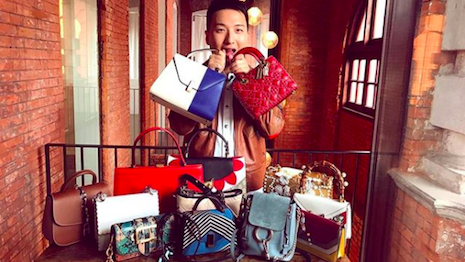While the fashion industry has embraced social influencers and messaging commerce, a recent campaign from French label Chloé demonstrated just how much potential these strategies have for luxury marketers.
WeChat is China's most-influential social platform today, with consumers completing almost every type of daily task on the mobile application. According to Fashionbi's "Key Opinion Leaders in Fashion Industry Report," WeChat also has immense potential as selling vehicle for brands, citing Chloé as a prime example after the Richemont-owned brand sold all 85 of a limited-edition handbag through an influencer campaign hosted on the app.
"The fashion brands are switching the advertising budgets towards the online channels and the promotion via KOLs have an important role in the new marketing campaigns," said Yana Bushmeleva, chief operating officer at Fashionbi. "However, there are certain risks, for example, the influencer can lose the trust and popularity or can even provide incorrect stats about his/her social media accounts, as the result the brand won't reach the settled goals."
Social influencers
According to Fashionbi, brands increased their spend on influencer campaigns by 50 percent in 2017.
The doubling of spend increase to the key opinion leader channel is likely due to the strategy’s ability to allow marketers to reach the specific audience they want and how.
While Fashionbi designated social media as the most-important digital channel for 2017, faith in paid search and advertising is declining. Paid search and ad spend are projected to drop by 13 percent.
The most-popular form of KOL advertising is branded content shared by influencers on their own social media channels, many times this turns into long-term sponsorships. Many times influencers become spokespeople for a product or brand, supporting them through multiple outlets.
Brands and influencers work together sometimes to create limited-edition products, which are sold on other outlets.
For instance, Mr Bag, a popular influencer in China, partnered with Chloé for a limited-edition bag to be sold on WeChat for Valentine’s Day. Only 85 of the bags were created with the limited stock selling out in three minutes.
Brands in China are significantly excited about KOL campaigns, with 63 percent of brands relying on this to cater to consumers.
China’s key opinion leaders are causing influencer marketing to evolve from content publishing to drivers of ecommerce sales, according to other findings from The Luxury Conversation.
KOLs such as Mr. Bags and Gogoboi have massive social media followings with global reach, and their communities are responding to sponsored posts and brand collaborations through ecommerce.
In China especially, the Luxury Conversation noted in its “KOLs in China -- From Publishers to Ecommerce” report that the trend is exploding with influencers helping brands to sell products directly rather than a simple branded content post (see more).
Celebrities versus micro-influencers
In the past major celebrities were the go-to option for a spokesperson campaign, but with social media the influencer does not need to be a household name. Smaller influencers with niche audiences can offer much more value than a major star such as a Kardashian family member.
Luxury brands have been embracing the KOL strategy hoping to create a following of local customers through local promotionals.
In fact, micro-influencers on social media have a greater impact than celebrities when it comes to branded posts due to their niche audiences, according to another report from L2.
Celebrities and mega-influencers see modestly elevated engagement rates, but micro-influencers have much greater engagement rates. However, micro-influencers post eight times more sponsored posts and brand partners than celebrities, which can over time annoy followers (see more).
"In contrast to Western countries, in China, the brands' campaigns with KOLs have a more commercial approach, the promotion of the products are made via live streaming platforms with a direct connection to the online store," Fashionbi's Bushmeleva said.
{"ct":"DcPzu8UUMecIW73CvqeXD0yPR\/oXJxJtazsjKPHOnr4GBQX3KCqP+95SE9duisVpNkie9sjC0gQlyt10SDP7p79WjH3IMBNBabwTWCTqk5Yp6s6CKGOSJc1AEtWmYuBY0urXBYBo5u3iEk\/pBUWV\/51W4N9hnpjLwL3DvS9BSa+qlan8y5dNPnc50IxsVErGyeFAwt\/ByHfOjB5vk9zSLTYWAWYVhqZCg2TVW4Uq67cab7uGCpru4XUse44WGCB4YrG4NhQo+25\/0C8zky94GNR7pWCPzlHJLAvHoHMvTmC+t2aQ98alD1c2I9etfdmnuYN+2D5xrJ3nThOgONPi\/Nhh+eXreDmIi5GBdmMt97KZOj3oYGiJ7+qtYd2+p3MkpsQVzpvoGJfBgIPAgJtiy1oP5VYRB5ATAdbyTfrDq\/Z8kjzQYXykbNcyhypUQaKNuO3wqBR6K+pIuj4n0FPaCLUK76wsJMNKSkhjUVArOYjshTVh4TPYsvEfRTHDFNd\/t5TFIMfCEtnkSlujKmrCxm+6W\/MvgzmoZZ2kaJC9+nBtPfSNA7GKz3rqrA3vg2F3VWJ6Y2+\/qL4rWWgvHqMLKtZbSJ\/nw0dvGDEP+1dA4VtU92c2TM2HRCMgMfwFwFkTUS2IOZOjCgJnSyYJPNl3a\/hzjJWJWcIjh4CnKtQTjA1nHLXOvZDoldy1Pz26tm11lldYohjUs\/TM9Rwq+8Q4wy\/LObif+15Dxq+xZhDSH3ClikBu2wRaa5A8nU1PIuYmaKoRjlMPZxmqdJ2\/ojqt133xOIPZkTP888IW1t9iGXW+6X7YFf\/F5IvAqN\/2MsNQ6KVhzeMJqFBLBMS1\/8oSdpfk9yql3bZHKomFmHUYwG1998\/OQl\/3RCmCPtE4GG7YRyGAaUaHx0\/WeGBODY2pPVmCoR9gl0YTN2cG8hrW+uvUcOK2ti1Yu0azg51QRfwiSNSzBJUQrqTM6ZPAWPsKpW9s8u1wjQtd0aBcEhAU10CJS3w4jovcjKqDrDI8vK7wnBOUMHw86w+a00j2BbAZeaYBXLV5LTF7okihnNPNPKzSmCKaoj7kXlU+VboWp36kpj4Y3BOT9ppI0M8CbiKRe9K7VUxezV2dJqpcu\/fmluMOzfu4Fbdo0ExD53X1YHz3fvavezPgSo2IpStQNnCEXC+jg5d44k9Z3vtFLPkPAyQjIJRDvSMOHrqNS65Y3y4Dgvwkm+ZbwmnlaLNIAlLjiyKSdguLF+L9o137ClE6HPZmv8rSGqDq4j\/+71XvJ\/4mTwabi1PtJs8PZR9cnMDoh8vI13hFXH8wr9ERhF+CJmRXHjn9xAFOD4Bgwl7KBLnUi0+8eQhnBMFLO8UKIZhG0XajrMfzB45XkOglMs9I87qro7S5kVN96RPv01rNSyUzw9AUzHbYmbixp6VUADSUK\/jBadFzP\/sMgqlLvcjVDlBevAEXTUJgCdwTVy3rJquCJQTopsoflb1RLabpCBPerCtVbbVVKF2eMBQYNKX6tHmfhkCa7Xo\/RBa63nxFH92u4nRPRYIKNtGI6tHnkhvgGQRxtPmy4I7CdDrQ\/NBNm9vhIt\/XFh0SPFs6AwpTryTZTGezGp7lrTBwTra2r8eeFxND8Wb437w5cGzoFpmDoD0EkcIlzRU5m8skSw+8eauZhkQ+DlgynlYYVteFDVPgQxnn94bzJkQRAIUVs+n9n36z8VQCaX\/2goQ51NoIub4zFczojKYn3Gus+tIZwaeIEvFJy7DPT5mkfy8Vng33epbqrnrUekPXsZqCZEQiXdUQVnFCzi22Qwg2g\/xcd6QuR5kfJN\/imzu9p+tSmGmnr5kafRLL6mtykRfyR9YrHdJBGa3mK5kcsTr4b\/88o+h9tVS95jqqVfEpAe2FmPPBSnOjV2U1jgrJkeq\/PTIYLJtRsnQ7yfKSGS1LWmMuIweUBUYLmcSss5DcdjOhIpC3W57ih\/0+qRoSjax0Q8\/Ot0xbSnwUT6Do3ZAtoOKHBElaTjFQfXU3uWRcL2\/78xpDqxlV5Gkz+AVb7StqpNzwKzNTHHlCifIGx3ttOfds5L1nzk91UmpowWFagPpv77xlWUJEWOtesGcfNl6EyFTPAliDmhdLWIQGoy3JDENqzrPLYNfbemlrKGk6ztgziga6lxyoy5dvFA8eg4WSPAxDfDSplUXSiqC8m\/dsZJ2+PDxsrm\/\/3qiaLGPJr0YPU\/ijjJgY78GaysfdHsZUWkDw63ojBezdvW5unuS9hrTUrEvmv3HEb9bM3QARvw2LilfIivknJAHi51wW+iba9V0hfg17YZ0pnKIghija9e4+7S9\/2Yc6uD9CxRYq0IwJlKhPXb2\/F+FnJfjh9\/HwEXQbG1hNqgY0xM\/qk9kXvVcfDtj4keY22FnfyPUj6cznNv6CqMs0kzMLsjzw306BpupAZUN+P\/ANbG9xIQipaUWl+VzM3nkReAMVqgWnTSByUJwUEi97WwZO5GWferZsxPLcObj2QF5aSmRnGKRhfsYNlXHjjF9Iizlf4tvOROOiUsklP7vZ7hwgdtVsJh\/u5L9yRezKKgsrg8wJ4F+KSXUo0t8FFWf+GHEO+7CUT8++VD3xrAn4Vg3eQL7j0eBy49mve4iXBQELAvav1+H+zyaOAOyK7GRfvpzZoIUhjWNzGs3hsroZBIKhrDw2JHXF1nVZzBtNUKixq\/W4LJ6NYa+eLp+hziTJqN5UDljIT\/PrX5goSRIEnFSioALexy9PpuiywQ7LC40sRom8r+3jETmxU3lHzbOenwnKx\/Siwgtzb40BeU7v4sEcddvwupTBoGorJFa0mBivrzjVi\/qkEwqM3x33cwDjlzZNYIa+azOiyPC+JJVhjzwsu98Tv74w\/qPowBTXqXnJ\/JfLD1uYuAXYx7va7NRraw6p0AsF9sPn7M6hmIrHBA1f8VPFfE3vTq1Cug4U80HEvNNHhN9aHldeX3Mv8URaRhD0Wv9gMfB3DDLsW7Fx0YxCjKRiHVreHeXuFrU+6GKNu1qoX5Rph6\/Rs0IHXTncffdGUcLdy4\/Ta5YFP60cOzYBsSNIUESkb46xd1YOASxqewa6GW9bMp3nb9AyZ9LUMzvAGEh\/LZBaD+\/V\/nXKB6ClN3wEirWOF12\/F7S1F430cE6Huh3\/X0VPRHqB+KOGRwaxEDoWst8l0eOioNZ\/shfidjfUuCWqOTNuSK8Q8VJGZtmr\/RoVmJz\/m8yd\/n2AAW16BJdqKvRH7GAdtskDhlwThW2BDwyM\/i5RzCYzjRvFGn\/DHb3\/0jzgaA40px2n0zKujYMrVEQgfA4wbKEHesBRlcrezy1mOFOM3FxTNHDNVPZbQeGZQEuCtZnflCpScxmB8e3DNlj0tttmLe0gFdjnRjWHwzQwQqeoDeTzV5Bjbh+koD3fycWLMIwUIIAhJKHG8OyzyUewF\/AL9P6HHJxmm+XZ7zRGTNpmhGrwbfr2ky3EvuNNSK4OqBMtn3aywbj7PYVD4DvjPuKUespOmlAFBKJBB+pdlB4gzsqd37GkHQpIgyJnKoaCKYcbGzov3QZN\/BSDQuv7uAZZD2DkRPI6r2sMr8ZKQXE7JmGfKfGeYJwKOhdcWclHlQBVFUVHlmq0c2YmBqc+GmuotN78GxT+TjKE2nZnjBWRjPNyomPJNOh44tsaD3UnGXS5gGWCt2+I\/hI+cbCfl5EwAormJz2jZzDadg1+Jt+3Oge\/BZD+umdg1dAEUJJNsJ+JYE9STps1GY\/l32wgEnsiMgU0+5eZktf1EAtWuCdmUVGZZqC5FtS+AdXU3OA1\/zqPWNZY1Wv+ppd+KQg6z+szx585YDpYw9HMdIiyjk4fR9PLx0SXruTHDNDu+C5nFoBmnydaDr3lmacoJdbvny8ttKMofQNgaHyJMa3PHwa58Ko2f\/LMbxZycdnvYgHYbBx1uLuC4XJsnkMjHo8X13Psh\/UaVplyjB2d9MpfsfVg9wPMuyaYQYGV6e4d+EXi3lfro0NeJPPXGC6XwGxU5IJ8eXeBkEo65PTx2MK1LoPDXlggaZhdky4WjguBqZd2hkpNzYIQvMhpnKwEAtS4fRDHLbXqXXkqU\/bm9UYl+v9LKiusPK2uoDta5KuIjAJ3ewF0CklixhpWxG1UhfFcAAQ13cjN3zWzrTbTJQMMBPFhVWGeFp3EkaFWBuvwxdhmJ8ZR7soDF+xv8HmqUG57xOlbMieyyj6eyZjj12coQXEWfvsUu+m8adCQuBKHOSI5pT2Ewho7NCXUoGd9omc9mW4wu5HQ7knvvekPbUTpNYeOY4RmVYb\/+J2iM6l37F5sWmbKH3uzCWnhwgJ\/yssLjk4r3Wd4lx+fgzNlsVwAQSdgzcwzkwiovvIYbkeIWClMkyoPd9CcM8S0bf4eFYn1PGeQdLzjnFeMU7nZlDdqWnGu7kD3x3FsJYhZDpJ4GFFfSm2pl7+Dl0IxxtOdUaqdVBi5+61Wo0veyCvl5J\/LtjSHy7MuDWKPF\/GWnLiUgQsZdAjmYTwlhcTAeMXpqJnM7sZ\/XoNJgZeRvTkj6UoH0iOIYrC1\/MNADKcnYj4UEonlDCpUmLH9p4woxH9SCeGJqlOqgD5gqlxWbNIF1\/6KTv8jwHTpn9SJDGFAy13M8y5L\/eZqCMohJdUYb4ZuKRm3LoZL7ZEcJ4A9TSdQeXNxK327LTW3JFqmkwFTdqsdK0P3NWqkcD0IZOysbM45U4owmTwS2lRkFXDmNM0pxm48PqqbJ++goaCkhMjqRXrngLZ\/r6knQX8g8as6ffgwjbFyTc0vjQLQHAuIgplQrRc5cf3K6g+jNsKtVr52OaUvgU\/VKAOv5\/he0SOJ0Kjkwh1Mt6NEHDShfCiUd4yv31sNzPNY1T\/+i3nuN0cVkIvwmn7rAIVFnWrXABcSSe99fK\/9yd6kIg0o7PA4fG0V1Rxf9SV5zAl6WBJxwBZdE7AsInCaGGjfT7EV7VovaVCbi\/UFr45xSrf2\/YsChN\/Gged8iKTvBUGKjaJSEnbcSl7zC7FPQvUtH4Xg2eMAsScEsUvdwHlqmR1Pf65NwfaT+a9zr7BNmtAVpF1VA5Aya78c8eamYtjIBEvIDs2gMcHDwDQF4vJKusSUhYyoSq7VEmISM4gHuzQ4IYteNu+Pu18BaQcKwrZEgqK71K09Xybw+CHAzAe1NpLee\/TBPZi6TXPlzyVI958WG8OlC674ek3TG6I8lZf\/5\/h0bFL4+oPPJi28HLBuwfXB6\/pFmdqB72tcw7OlEQ5Gw2q+0AR9HVa\/AZ1wHsSjgxgPS\/tj3xD2dakals7VLpE+fKlFVEiNlORsUNS6E4MBoPsDKpYMOxS4uQ3\/biUwSs0hnlm7FVubsNR2nTidfMjtXU5CrtpGh3YELMRzCgXQLdMlvOyg6xxR0OTpCpdHO1+Dmzx0+NWXZmQYJTfgegcCOspWuMzKMijoZKlP6AmpiPQHXjaj4l3ls0N6UePrDR7Xc3Pse+cX7vLlDGcSAmYY8Vq9UXsd5XS+vrZK9Jv42lNs3OKmQZJdxZf53C9k3ZS2trISvthqVdWx57I22MDYHwijskIupKisR3Oe177V5tbRfzG0BJc9TQQhP7Ad2PfMEFioEQBHVZGg1po5N3gz7vg9nqZgn3yoS6gBAARfqRVJz9t\/HhrS\/8pxN+FAHh5GqCwUlQKqr3so+5Am7A0ova408PQ8yKONdzCmyba1KfVplrbQTG00lG2U2eqbmsqkLfNUYQrin33Nt7Vqz\/u3BT9Z5e+aaWiEYg5Z9pzwbc81vcyNUjaIBSRhPAsljGHHVJGJ7m70h8VqgvuICnWgJKQf9lffkxIorTbPqPPovXTnOHwV\/LfP9C3DQ054HZ1nkrGNFulQcaI5Koeb9x6LvLBSZI3UtOKh0ZT32ttGmfjt9RHaa2AupbesY4SrsAXPNal3PNh38nPmqZTO+TC7DhROmtkXNaljYcOVKm4Sarb7LPlIILGyXGoieO4ws5cprollVKu30Xce5APe1yMgDU2kIBCmmDR2pCwbwCrJK3uNQnoocR7TiMoZFxZYcY9Gk4udX8Lglt7r5J63gt9Kpo6Bj8HCH8SYtN79mcKi+tFgxh0T\/\/1NLx2\/eQvpxqkUE7zW5\/jd2d\/rQ+pwPg97f2qxd\/FclELnybTgMoCDkt962XVDdNnyhBtT+zv0EeUC6osEwm7BA\/Hp2CdLfNGTME2iWpuYCsneylhjyrmIt\/du0sVhv6QvJQ0zUuAL6YnAgPlQxLHtH5Kl0dYLsAbUGaUb5ZRpT6Udte5+X4gkhBlz4b2PUegFer3w+YY+x1xYfKhUged2m2jQeL\/eV3XtkXeufYlfvfwasaGx+3EdM6aSyxlAywHZaVnKFZAWbC3BFNvj9VgN4avgZI2FyXxtHqbAHM\/eaQQ5eg+ZxzbFGuTjP3xgPqkjQ0DR9jtpf+mq1us\/WqACm6kcHVYaw+Bc9pKfIxQWdJuN+Gg8G3DambyKPqS83w4EwDcNiS37RVW48VrfRn3UDJCvobDltNPdDTdisVbfudSI0wIYac3vQ8TdYv7sKmzh9TGdszIUVmLSrSafZ7CR0V7vTiIPF0gqVPEa4v1AN5dutNvnz7pHO370vCS9l2obf3O+bmG1LR7W7UxmVwOizgk+zcdQWSbGtGpXaFX24Kv0F83U\/vGyLr34srtjkpMUbd8LV+KsIEFMBzejZEp6XmfGEolZ\/k2GArYJUUo6fGgyZ2\/ndxC6q8mQk0b+6bW3SIefat1pTjgr5VEaezJCvD2Ft14r9iAsbiCB8KmCx\/bRi5\/9XI0Iy25PL8CZzyg3+vOOKy5kZ3MF4e\/c\/XxC08SjelAV7Ah5kI46R\/Kl9D86mtMaWhG5N2t2zFiy9MRtfOGcZQ1DzjIVc9GgYYeRTcI1JHw5RdlKbpZhBvFkdf5Q+g0MyNv1RaGZISns67FHXtd2RW5aEXYUhKwv0Vd6rOW95Mp0sGxZtiDgTy0Rmb2S76WW+yO8SI1B+RQV63pe4D4nsAOxQdAGwQr6Zb1EnFcEntu8zdzfdmGJbg8KF3KuI4SKoPiWwJndFVYxLZeAXOUJQII5OhlgPOmrzvVXpYKH\/slw+Ieut1CyLI94uVpJS3UhunqS1dn4z9sPv6S2KWT+0QjuJgieRgwMujhYrYn2HsnTvZUg2ljsKXALQccUAlZC\/m3TJAt5WWWgDdIi52u3J3MQlS8lhYKmqXB9KShEFocQ2pFzJKRYWmdaFpqeIK2FWj0wk4MSz7MpYq1kkwd92\/ZFI3n1D4W5IaY5bVe0sbN9k2bDWudo8+U6cjqzdcvq7i6kZs4TsMs0iAgS3QC7hWk25PLO8rCwETPInwk6Uq0xfSfVT6\/vrjfzvxbTb3YvCBF9x4CGc\/S\/CIMJBRo2Z6omQRWxU6\/977X3glAsr+PwVNM1u8f6npPJ8yEiD6ybw+ib7IuUWHSoyxKmTY10SO2FbI1w0fC+Wc7AIBfOMjDxl+ugvU3xRG0xZzj3Yfok9qWYk8J0zRj0tGM6teZPe94juJEWZAzVVMncxiFkDJ\/ny\/gCYbFX20efuSSVKflblTh\/zMimskewgSWEoI6NK8adGgHLG\/HY+VBS+Djx\/B+h\/\/m\/JT44Z4h0cZrc\/5IOdul6onS8hNSx+AkoxCxGMaPxrmzHmiRs\/nq+dtWREOY0a0x142+wRJ2gYgGZ92jOqM+vzsDQTDCL6NjZ\/rfyh3Xm4Je9fAftXFTbn6o8avKJOhp4DO+74YkZFtIv91lTA3mvaT7SgNcre6r+1l8aCXU4TPp0bGRxUKKgk87mK2cfpSlLynIW70NL\/GY1qqWdaMwPDX4kwPjtEzNpuWQ1CiKYt5dQ+ZTIcKSZ+sd3IkGD+nIx0vcsEOvvnTXOjdRyFYdiSH0fyOwUEtZyHRpxVBCiNoMfeP6i8EOkF7J5Y3PIdzN0ZpnUIYwZW0SKoN\/DnQLDOEv7hEXEFbxN434SvIFP184fjTCStoLfZ4YlgtnKfwtEyYPrr89mA8hzM2qRP\/1OF6YSWBpEnmE7W9pEvPXQwGwj+eZG53VZJU9pp1zXb019HLQGl1JiIuCzCSO2+w54jdXWAmC6aIgdol4il37d+qlcRDBt6vTfjqOOsMnQgsdYbp3MqVuDuZpmKGLbnN9D\/owFg7IoM3NFOKvM1CaikmUukxqze\/uUJ5qecPmTT7rftJscLsqTMrub57IQDdOajw6E90YTy2KG0BE112Adl6C+9rq+9IHF4QsB34AtU2nnP1UzchbvauQhOchJhsRMVP7Tvby+hKBDL9bYmra\/2UPDhp1UEW23tbbpsdBj8RtzQ3gtYNXpNkI5d0nopM1KMFBrBvnwiUyWjTpMdUOXVOswCo1dfUhTQe+8x+PPt509PjgVSHppNSLGXjpFxyP+C2AJIi6O5\/23hAiGYagl4h5tAKLoUZoaz3oat6qZ0yOPyzZLiit\/B2Ar5xv64UuZKYpPKvbUtT2EdEtTS0Q91xRMGC88nnBpQX+18ZfZbEEKayN292te2v81XPYHvUqy8vNTokzapmb6HD6d0HCNZ6eysOEvi\/gA0nFo7367AosHEAbT1oJSmPDx5cekwwJe9JJ9PA75vpOyvDdpV21TS0GsQWQiDyYHz9AflkaBeGQKoOFzqOQuTBg6EHzHsMWV+6i00iuGTQC34OzBBarMAJiTFL9VGghB8UCNEtgjjIIsxES+E0IyAQLmNAtHEghuUtvogyjFUEqmzIIjwRFgIbp7l5sPaxPpaL4eArg1+I9Kt4Q0F2M5XiIPazWEzcEIyG8Rqc2VF4MTmS4kIIS4ejpcmwPBfnkZcIDgev1pq+m77guCfWY\/5pIaXe4JreXqaBDP\/gFlZjujkP2+Sd0qoT6cHJe\/YXXJmCWlEIa4l8+92Cdb9Vx\/6fW+sVM19+XrjbLwoVu8KLyyjdaPexG6IRxD4oz2aGejuP\/73OT734XNGB7OPaeELAmPN8BSUTeIWXEgheYISQ+OUfqMg7dYl52y4B0PnjfwCKzyqxMN1QbAG1KCtdcp8OFlWwi9X3AUqtXtYabiK\/4GlJ7Q5S7Hhlj+u9BK6KePKb73Pf5dpJRn0VApJGJSEXJAo3FQOERiS5vpZ02sx\/Q\/cFrvsporNuerTrL1A8qorF8mmhE+9bG61QrgBXtTMGchdl75rkS9f2oLfdH2T6B4Tm4OVh2rnjejWU5hGn+ySNA9\/g5+k3Pb5fgB5bOkQDpcMeRzNvbTOdYbTGnkFWQa1Gx5SCq6cSGNHcbVJeac4V6xPnG5xDa6szmVuuaiNx74Rbcp1IzDHrdcBd\/oAkL1CgqcE2GK4Qrpf\/gA04nmAEgSN9mOms941oTvB5dxZEFcMof5jhTbzsfra\/Jb11n3O9EsSaxACNxmOPF1fbxNCn99H5EMdTigUlE8oXEf\/cDr7F00SyRdp2Z8NSlq7Hj2h1lBb\/ZAZWRDb5bO1jUGctLJFVmGCwgV0cVmOe3AOc4a8AW2BGYjevMGg5DjaM8KPCZwwt+KMhI7bkGiKifikElz4ZBKeY0u9kchx4fNH\/oCv7c6rm8d4hyetsfneyqBQytX71Xvioi54zU3Zc5pdsPNLcfaN2wZ1Pk\/+7TUdDSInDXwWCeUTVyz2uni0XxoTTzRTSn0BMkhAiexPr\/XJoKJ0DlGUBtFDmnKHtQIixE+Jfi1sY9D32hLN4o4xBCiHd7OgrlzHBz1m+AxiCegovvTshud6xLCKpbQVweJ+be5YoIyDcWnC6oqX\/2Rxi3Btq\/bbQE1Tl2VyY+KoUtwBgF0+z\/uODRISKrLHG2deo\/GfO7B0L9NQUNQz\/elMlZlFzAABcwUQ6ofTrNgetAsC4EXO1uEzMy1sw6d8Vn57E2O95c+ZYl5j578ngMN2g0yUS7nGnYHuA==","iv":"828446bbc07e81a930d0e90df6d8ee24","s":"c57ae7983e715654"}

 Mr Bags instagram post sponsored by Grazia
Mr Bags instagram post sponsored by Grazia